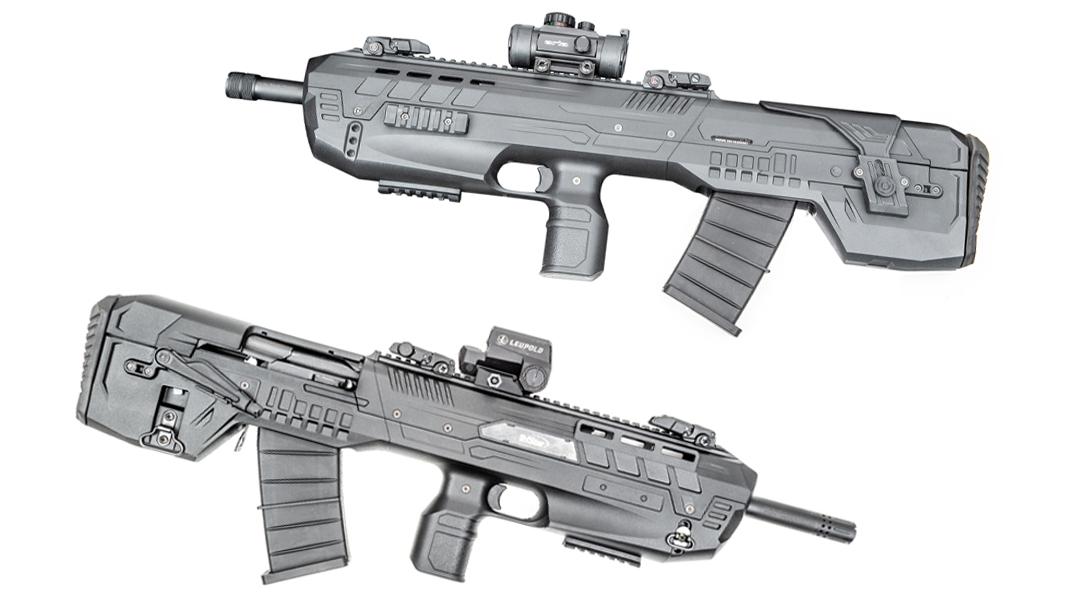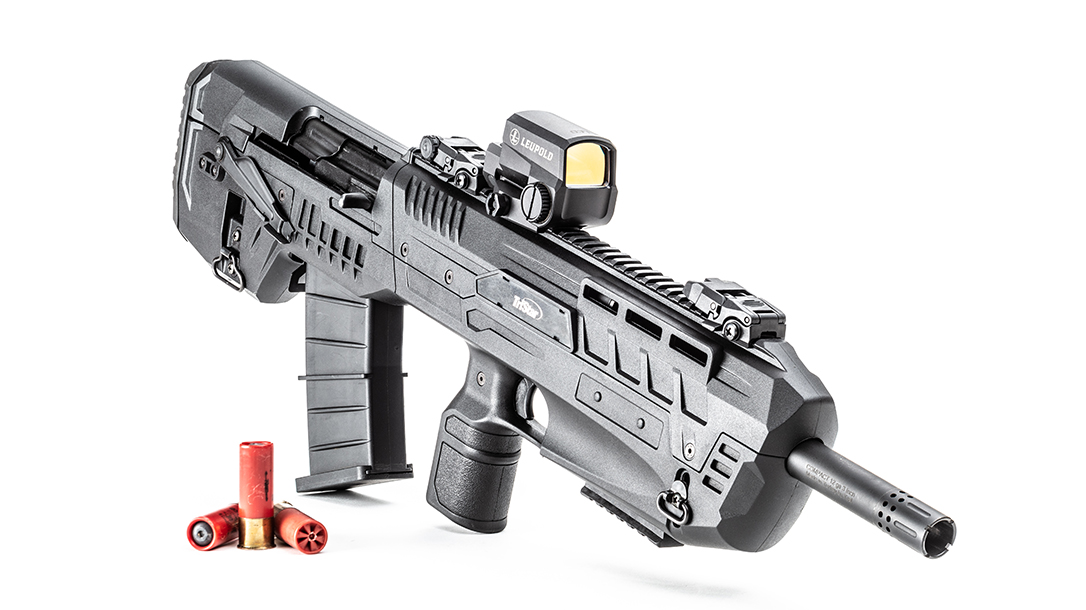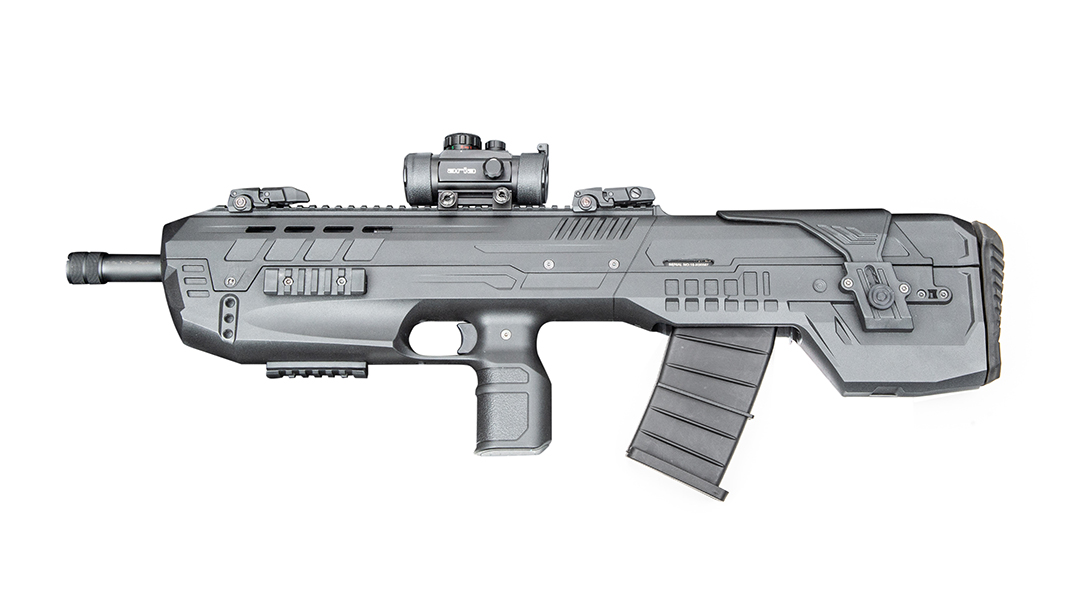Shotguns have been go-to firearms for generations. Double-barreled, pump-action and semi-auto scatterguns have all played important roles in civilian personal defense. Many law enforcement agencies and military units have relied on them for close-quarters battle as well. But today, shotguns are being challenged by semi-auto rifles and rifle-based pistols for the title of “top dog” for close encounters. On the other hand, makers of shotguns aren’t sitting around crying in their beer. One new contender for the close-quarters heavyweight title is the 12-gauge, semi-auto bullpup.
Bullpup Basics
Some years ago, my friend Massad Ayoob wrote that most shotguns were like artillery: big and really powerful but not very mobile. He suggested that they were best at engaging targets across a room from behind cover. However, 12-gauge bullpups are more like tanks: fast, accurate and very maneuverable. That’s because bullpups have their operating systems moved back into the stock. This allows them to have all of the power of a gun with a full-length barrel while still being only about 30 inches long. Compare that to an 18-inch-barreled tactical Remington 870, which is about 39 inches in length. That extra 9 inches makes traditional pump guns and semi-autos more difficult to maneuver around corners when clearing hallways and rooms. In tight situations, the longer shotgun is also more vulnerable to a gun grab.
Advertisement — Continue Reading Below
Companies like Kel-Tec and UTAS have come out with pump-action bullpup shotguns that have generated a lot of interest. They’re a step in the right direction because they maneuver fast, but I find them somewhat difficult to operate. The compact configuration of these short pump guns places my hands quite close together and gives me less leverage to pump the action, especially when I keep my arms tucked in—as they should be during close engagements.
However, the latest bullpup shotguns are semi-autos. They don’t require hand cycling, and like most semi-autos, their gas operating systems help smooth out recoil by turning the gun’s kick into a push. All things considered, these newer bullpup shotguns have real possibilities.
Twin Turks
I recently tested early samples of two new Turkish-made, 12-gauge, semi-auto bullpups. The first is distributed by Inter Ordnance (IO), and the second is sold by TriStar. Both are made by Kral Arms in Turkey, and both have a basic AK-style operating system similar to Saiga shotguns. Turkish guns have been improving in quality and reputation in recent years, and these two guns show good overall workmanship.
Advertisement — Continue Reading Below
Since they’re both made at the same factory, the IO and TriStar guns are very similar. The IO’s barrel is 18.5 inches long while the TriStar Compact’s is 20 inches. Both use Beretta and Benelli Mobil threads and come factory-equipped with chokes. The TriStar Compact has an extended screw-in choke tube, while the IO has three screw-in chokes. The overall length of the IO is 28.5 inches, and that of the TriStar Compact is 30 inches. Both weigh about 8 pounds empty, with the balance point behind the grip. This places most of the weight on the strong hand, requiring considerable hand and arm strength to hold the gun and operate the controls.
These Kral guns have operating handles on the right side of the action and should only be fired from the right shoulder. They come from the factory with five-round magazines and can also accept Saiga-compatible, high-capacity SCM magazines. Their semi-auto gas operating systems allow them to cycle with a variety of loads, from 2¾-inch tactical slugs and tactical buckshot up to 1.13-ounce slugs in 3-inch shotshells. Anyone who uses a shotgun for defense should be able to find a number of loads that will work in these 12-gauge bullpups.
More Similarities
Both guns also come with detachable carry handles on top. The handles include front and rear iron sights that are adjustable. If you don’t like the carry handles, just remove them, and the guns become “flattops” with top rails for mounting the extra sets of adjustable flip-up sights that come with the guns, or you can mount an optical sight. IO lent me an Aria 5-MOA red dot for testing on its gun, and Leupold lent me a 1-MOA Leupold Carbine Optic (LCO) for testing on the TriStar Compact.
Advertisement — Continue Reading Below
The IO and TriStar bullpups have short bottom rails on their forends for attaching lights and/or slings. The IO gun also comes with short side rails on the forend, an adjustable cheekpiece and a plastic case. In addition, both of these Kral bullpups have manually operated bolt catches.
Finally, field-stripping both guns is more complex than disassembling a traditional Saiga. Taking the bullpups apart requires removing the carrying handle (if it was mounted in the first place) and removing several screws so that the entire top cover can be lifted off in order to gain access to the operating mechanism. The MSRPs are projected to be $790 for the TriStar Compact and $780 for the IO.
Hands On
Although these guns are well made, I noticed a couple of issues that affect their handling when I examined them on my workbench. The trigger pulls on both were quite heavy. The IO had a somewhat rough trigger pull that stacked heavily and broke at an average of 8.5 pounds. The TriStar Compact’s 11.5-pound trigger pull was a bit rougher and also stacked heavily. Bullpups generally have long trigger bars with pivot points that must be carefully designed and fitted to ensure a good trigger pull.
Advertisement — Continue Reading Below
The second issue concerned the magazines. It was difficult to insert a loaded magazine in either gun if the bolt was closed. With both Kral bullpups, I did not have the strength to insert a loaded magazine into place with the action in battery. Shotgun shells are quite heavy, and magazine springs for shotguns need to be stout to ensure good feeding. Therefore, I’m not sure this is an issue that can be easily resolved. My personal workaround for loading these bullpups involved pointing the gun in a safe direction and then locking the bolt open. From there I locked the magazine in place and released the bolt to chamber a round.
It’s not a fast procedure, and you may develop a different technique that works better for you. In any case, I’d clearly use 10-round aftermarket magazines in tactical situations to cut reloading to a minimum and, as always, have a handgun ready as a backup.
Advertisement — Continue Reading Below
Live-Fire Testing
Of course, the true test of any firearm is how it shoots. A gun needs to be accurate and above all reliable. Therefore, I began by running a reliability check. Both bullpups were loaded to capacity with a combination of shells ranging from 3-inch slugs to 2¾-inch target loads and fired as fast as possible. Both guns did not eject empties when the target loads were used. But as long as I used full-power and tactical buckshot and slug loads, the guns functioned very smoothly. Next, both shotguns were fired for accuracy with both slugs and buckshot.
I created buckshot patterns at 10 yards, which is a common distance for engagements using this type of ammunition. My 00 buckshot for this test included Hornady’s 2¾-inch, eight-pellet Critical Defense rounds and Remington’s 2¾-inch, eight-pellet Tac-8 ammo. Both functioned perfectly. Patterns were ranged from 2 inches to 3.5 inches for Critical Defense ammo, and 4.5 inches to 5 inches with the Tac-8 rounds.
Due to the heavy trigger pulls, the slug testing was conducted at 15 yards instead of a longer distance. Using Federal TruBall Low Recoil slugs, my five-shot groups were between 4.5 and 5 inches with both guns. And I had to call a few flyers with both guns due to their heavy trigger pulls. Given this, neither one is really amenable to fast point-and-shoot maneuvers, which can be very important in CQB.
Advertisement — Continue Reading Below
Finally, for those who just have to use 3-inch slugs, I tried some of Remington’s 3-inch Premier Expander all-copper slugs in both guns. I was surprised at how well each handled the recoil. Both test guns just gave me a hard push backward that was reasonably tolerable. I attribute this improvement in felt recoil to their low bore axis and semi-auto operating systems.
Real Potential
These compact shotguns made by Kral have significant potential, provided they can be equipped with lighter, smoother trigger pulls that improve their point-and-shoot characteristics, and something can be done to make reloading faster. The CEO of IO discussed my concerns with the factory, and they are looking into what can be done.
Other than these concerns, both guns’ short overall length is clearly advantageous in tactical situations, and their ability to throw tight, even patterns with buckshot at CQB distances is a very desirable trait in environments where there is high risk of collateral damage. With some refinement, the future of defensive shotguns could very well be defined by bullpups.
Advertisement — Continue Reading Below
For more information, visit interordnance.com and tristararms.com.
Inter Ordnance Compact Specifications
- Gauge: 12, 3-inch chamber
- Barrel: 18.5 inches
- Overall Length: 28.5 inches
- Overall Weight: 8 pounds (empty)
- Stock: Polymer
- Sights: Flip-up; carry handle
- Action: Piston-operated semi-auto
- Finish: Matte black
- Overall Capacity: 5+1
- MSRP: $780
Tristar Compact Specifications
- Gauge: 12, 3-inch chamber
- Overall Barrel Length: 20 inches
- Stock: Polymer
- Overall Length: 30 inches
- Overall Weight: 8 pounds (empty)
- Sights: Flip-up; carry handle
- Action: Piston-operated semi-auto
- Finish: Matte black
- Capacity: 5+1
- MSRP: $790
This article is from the January-February 2019 issue of Tactical-Life magazine. Grab your copy at OutdoorGroupStore.com.
























